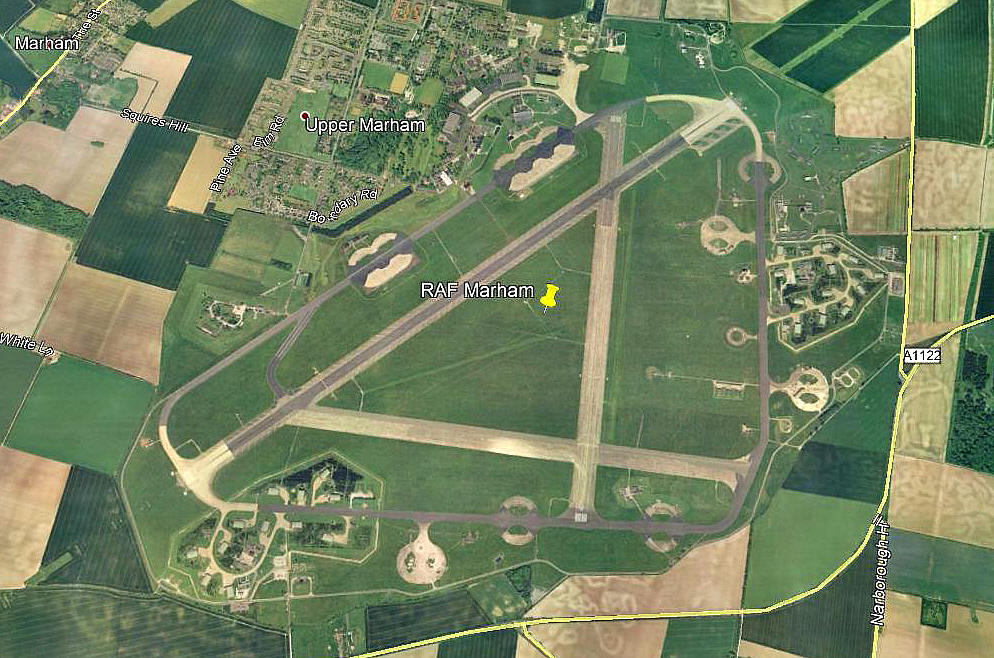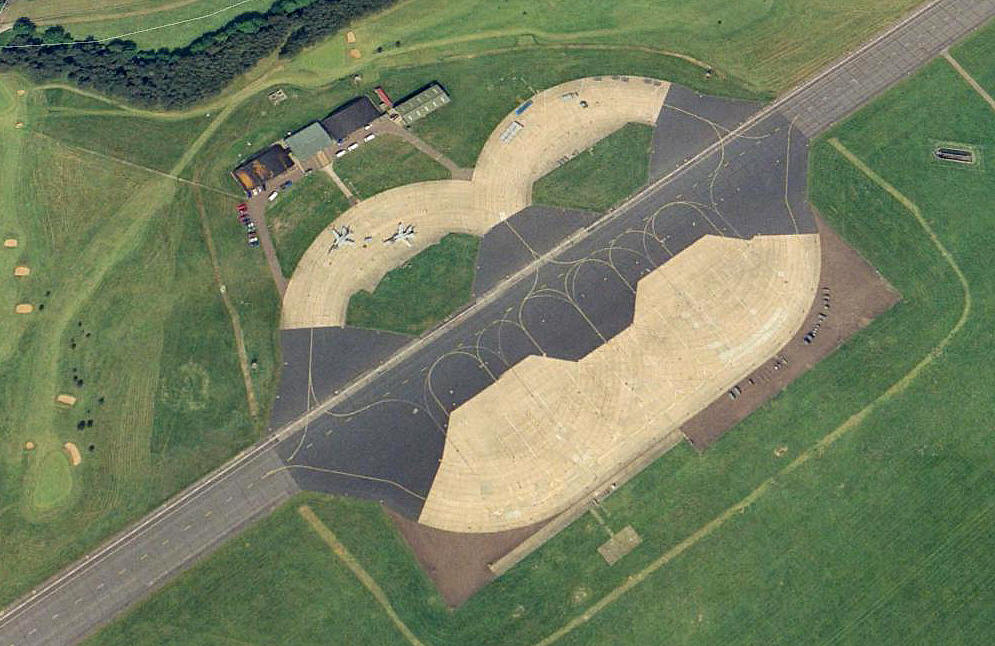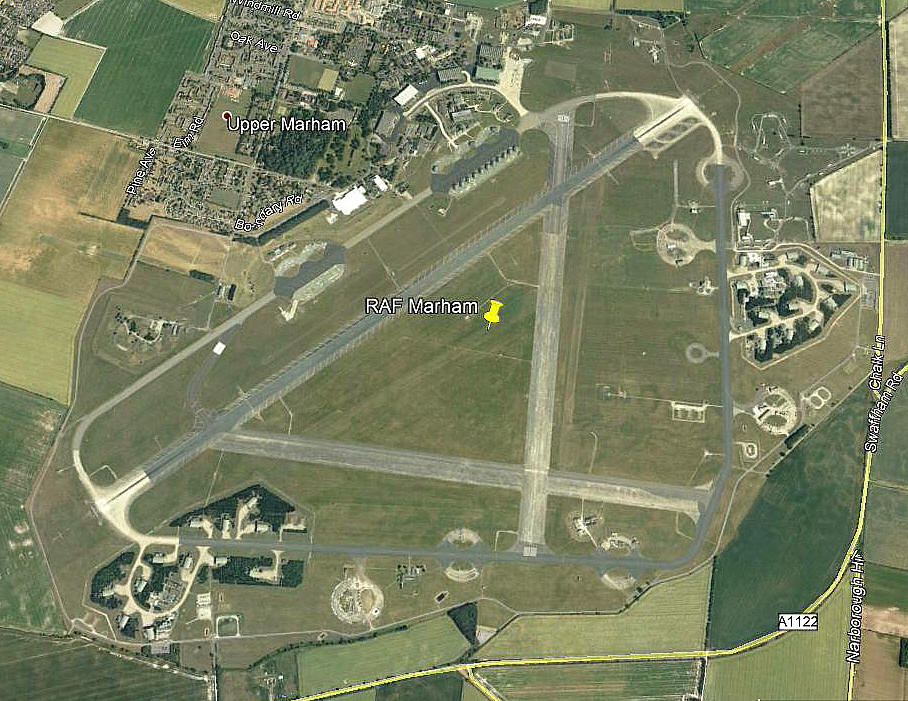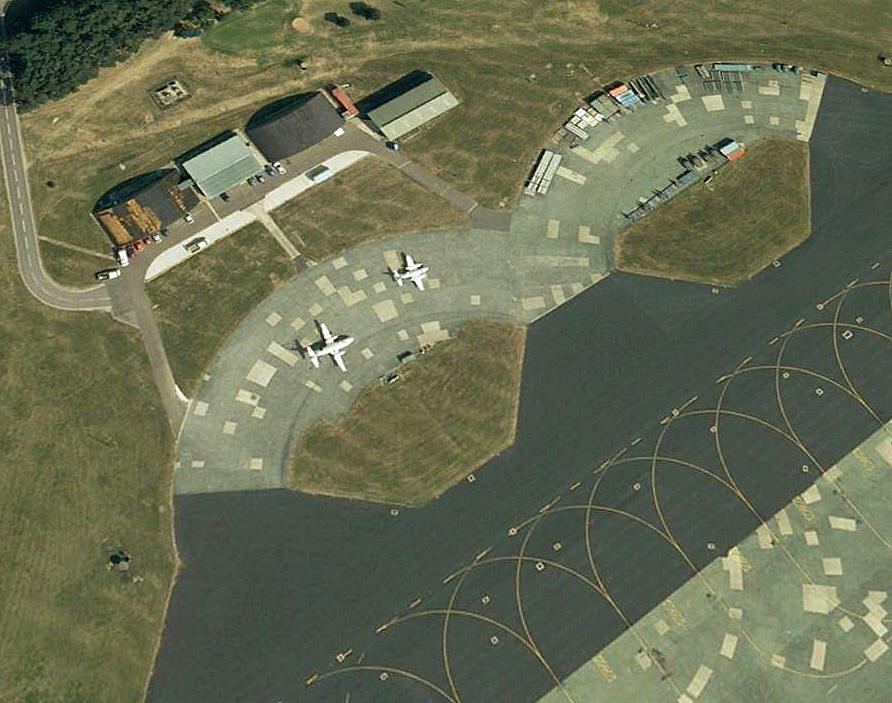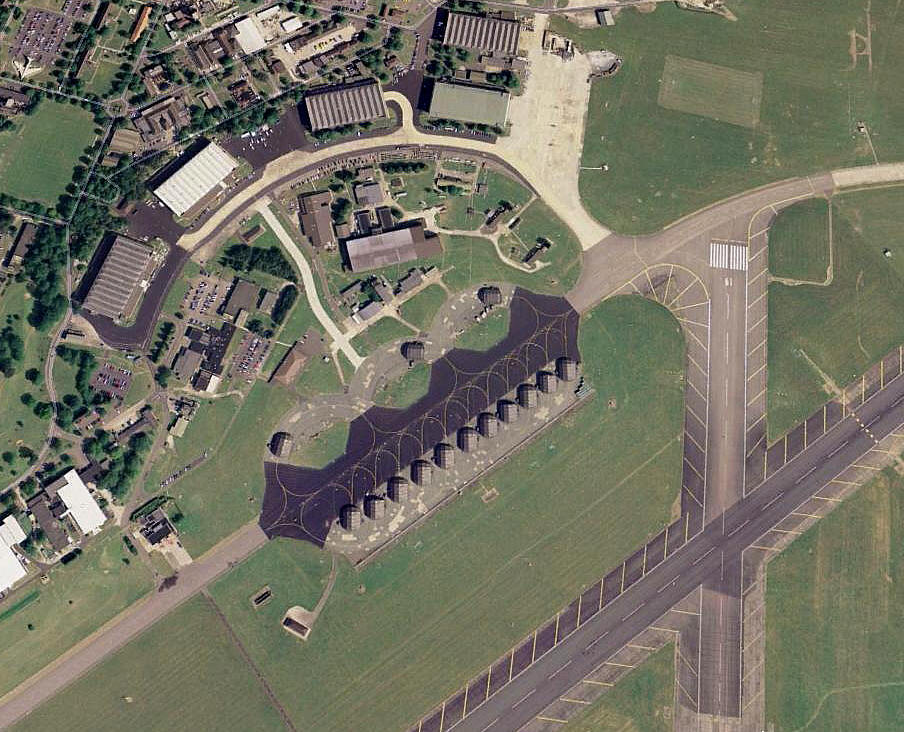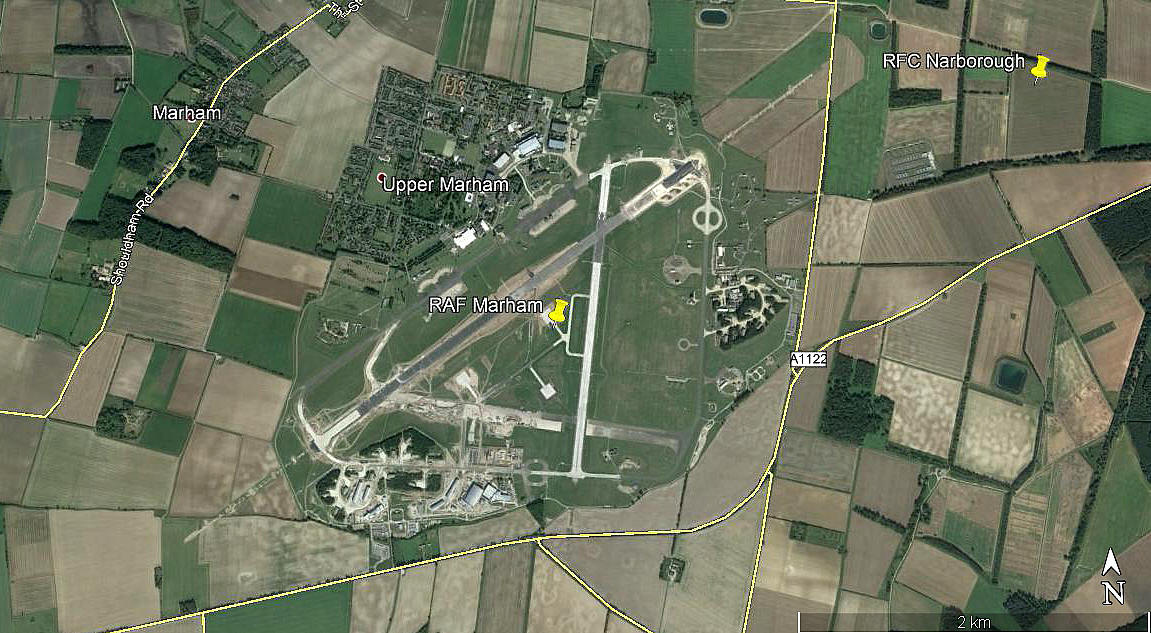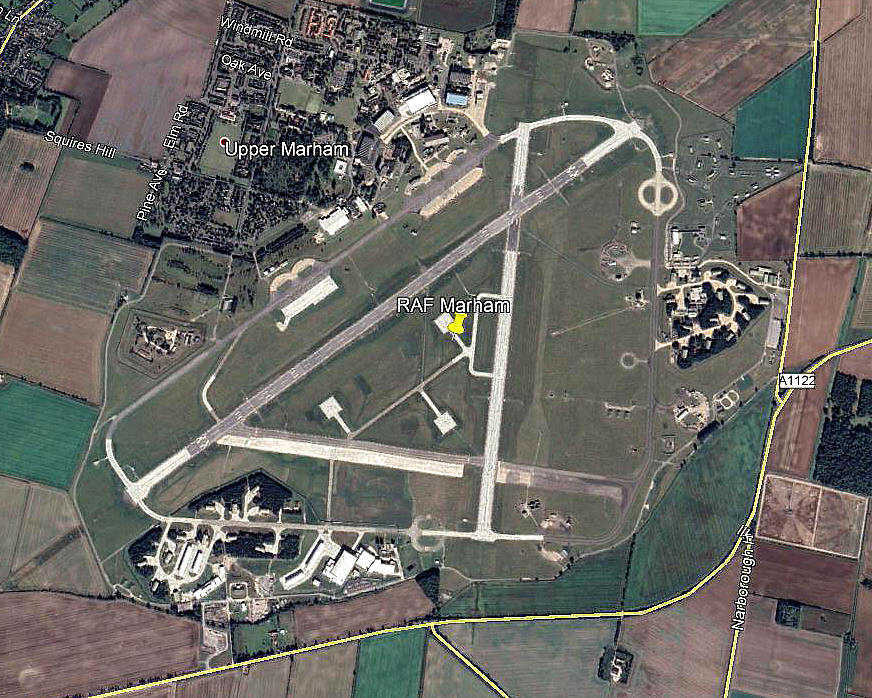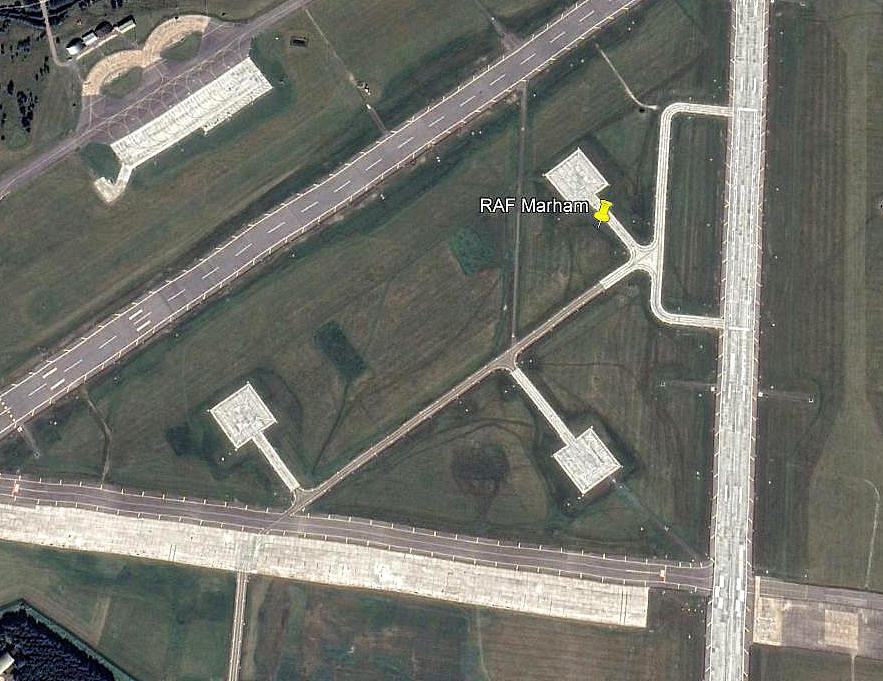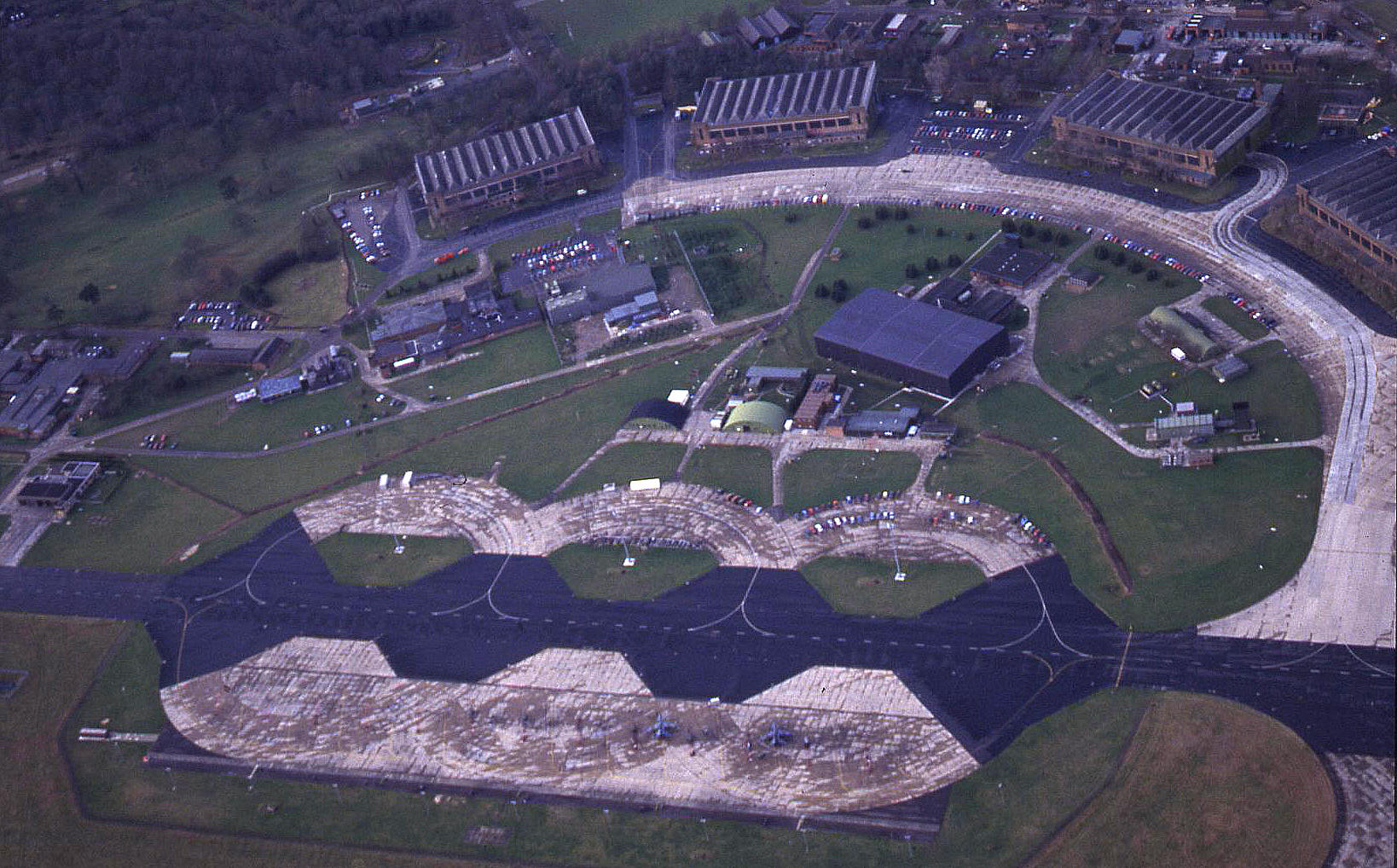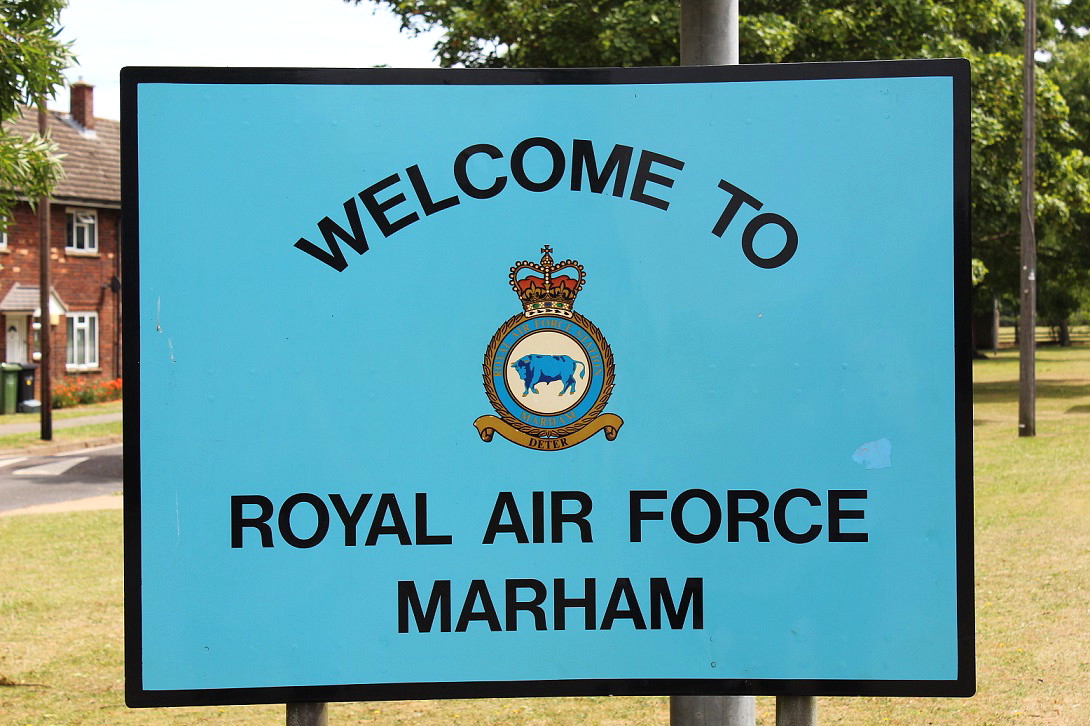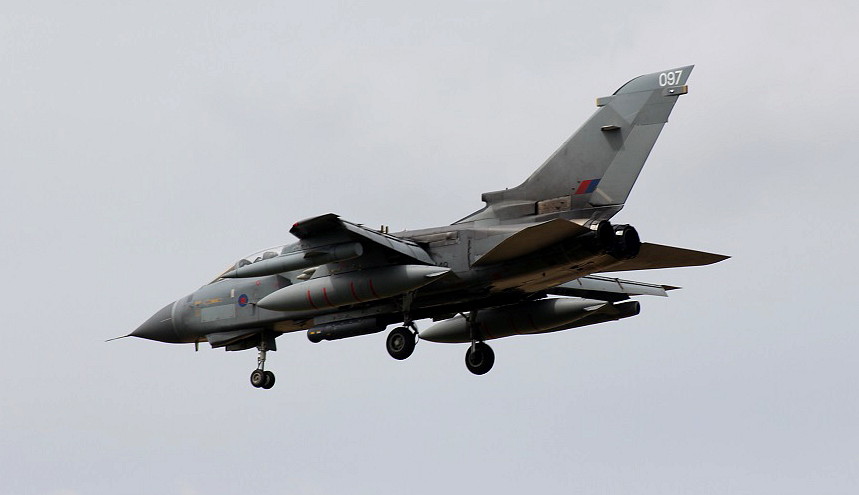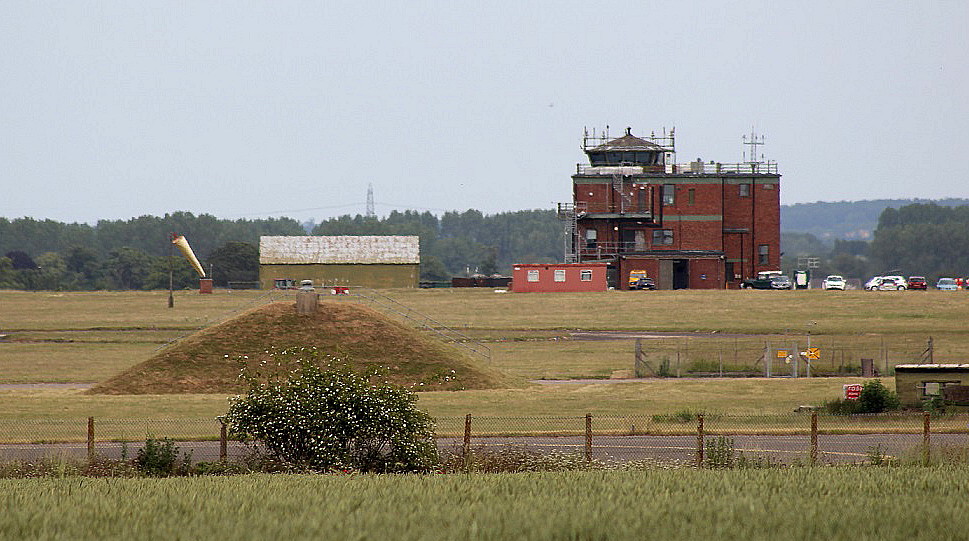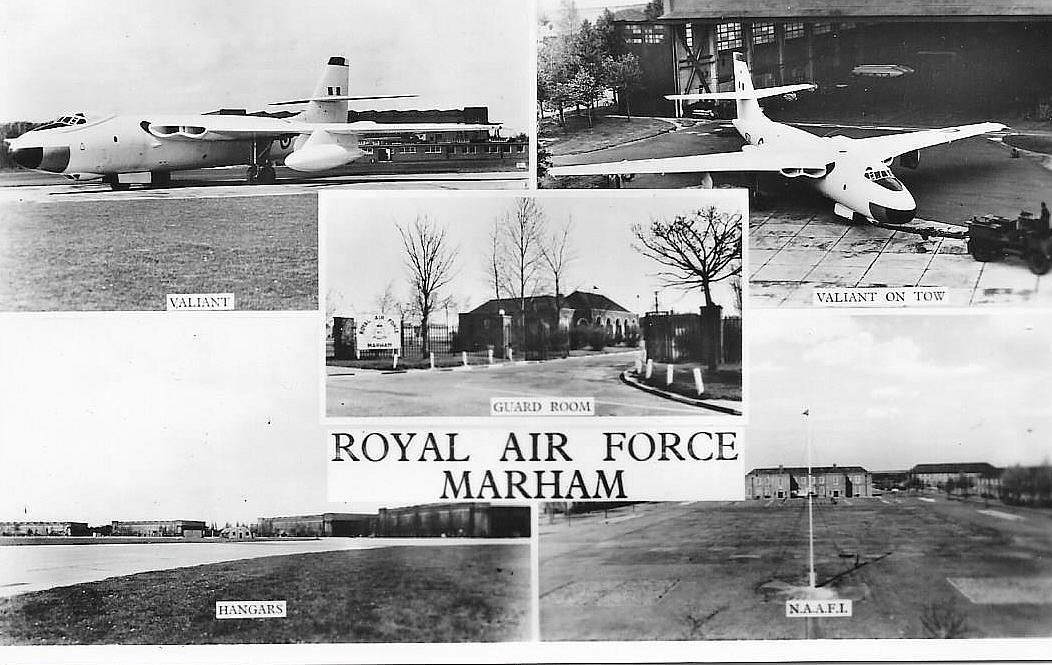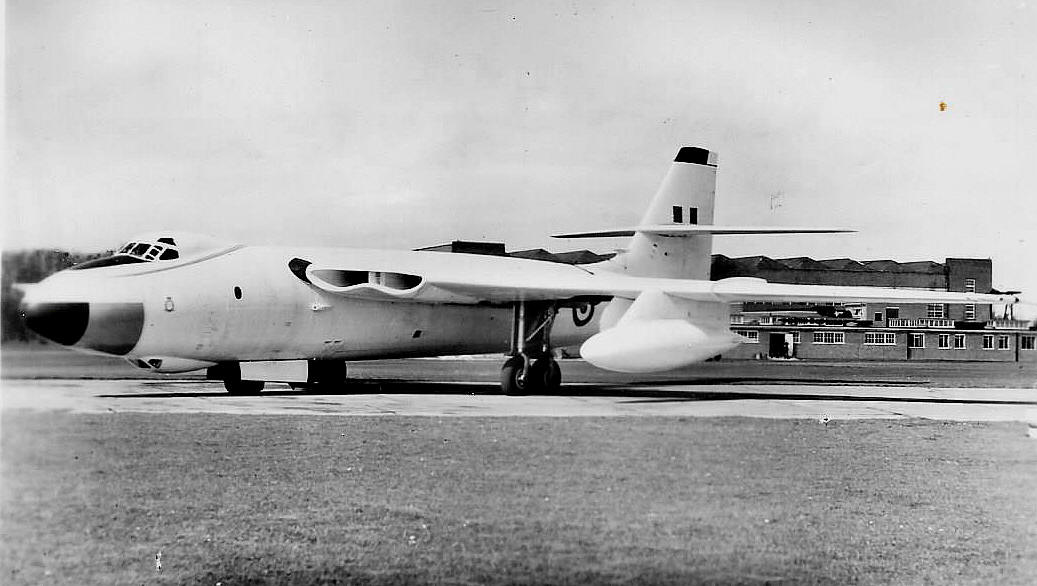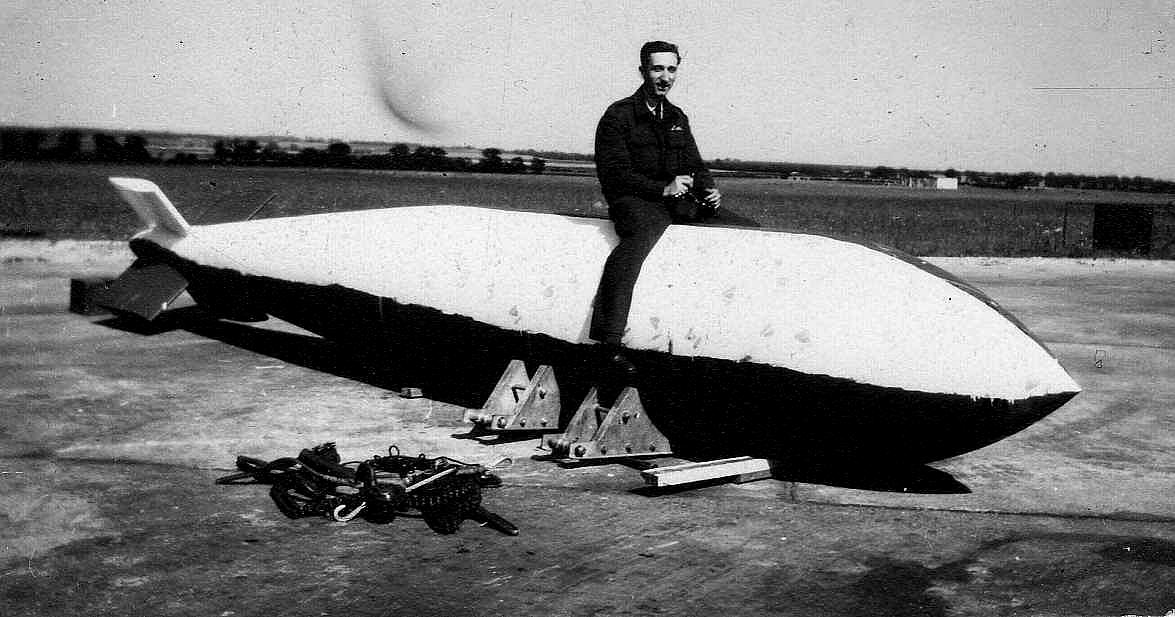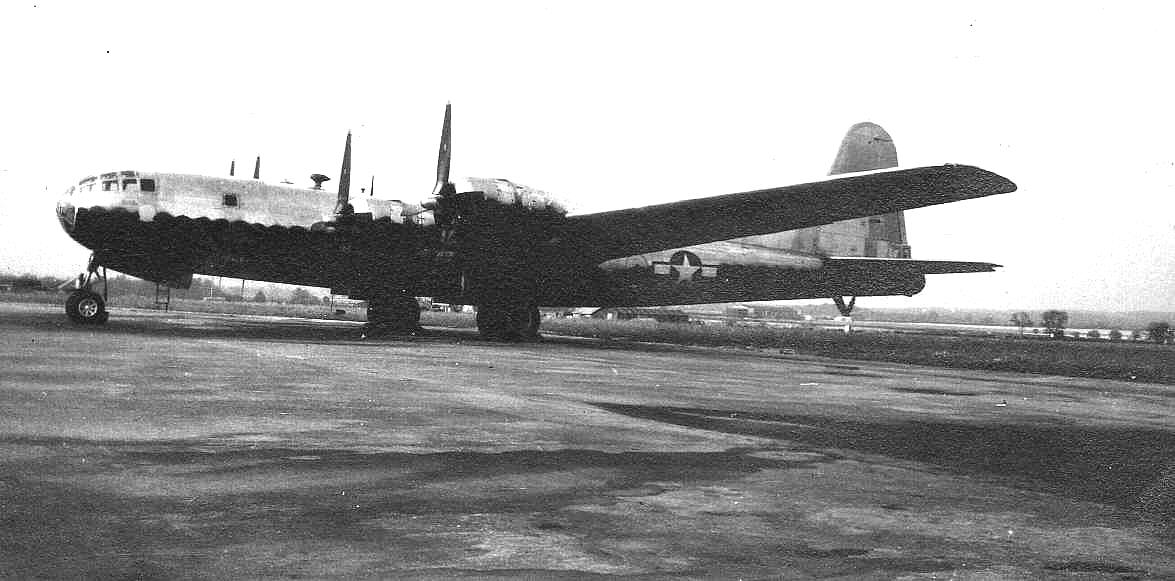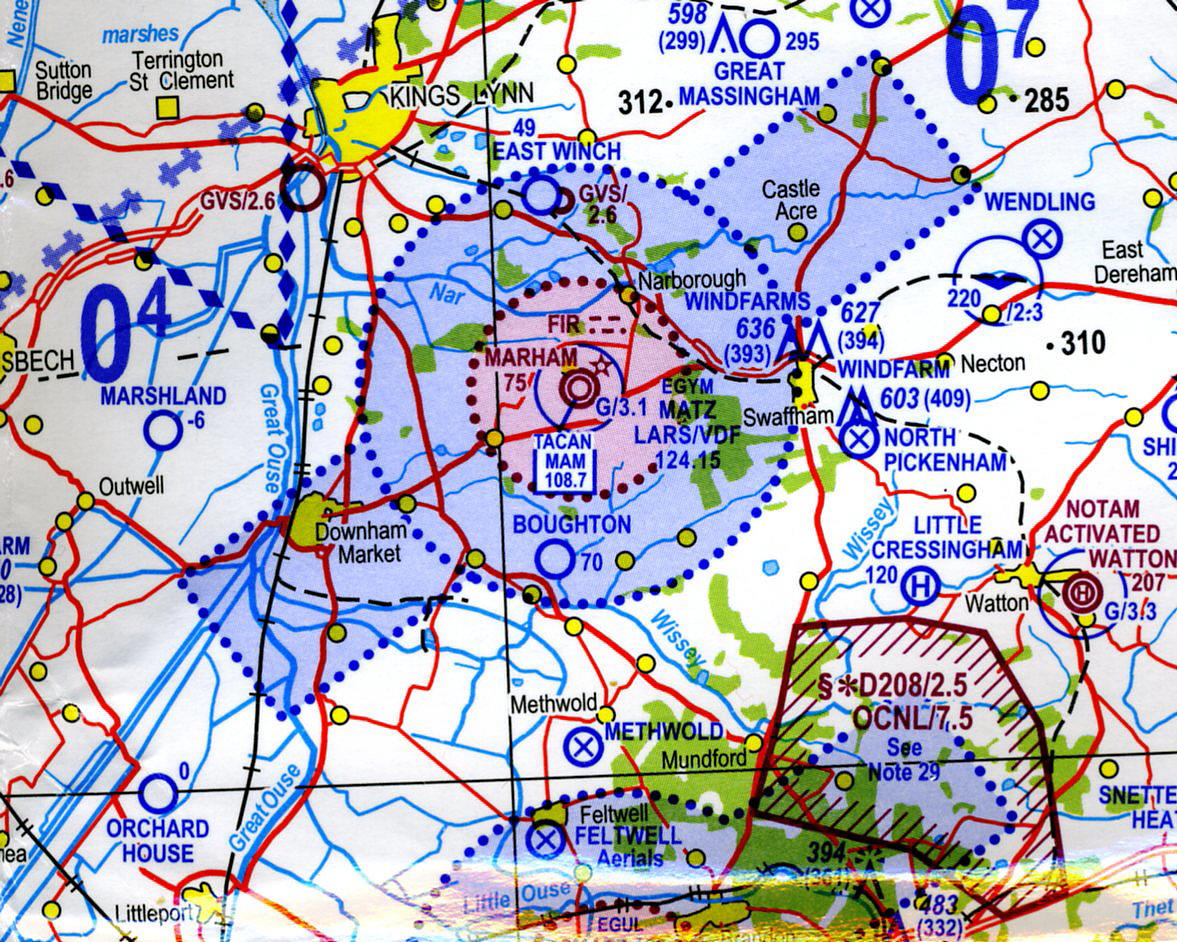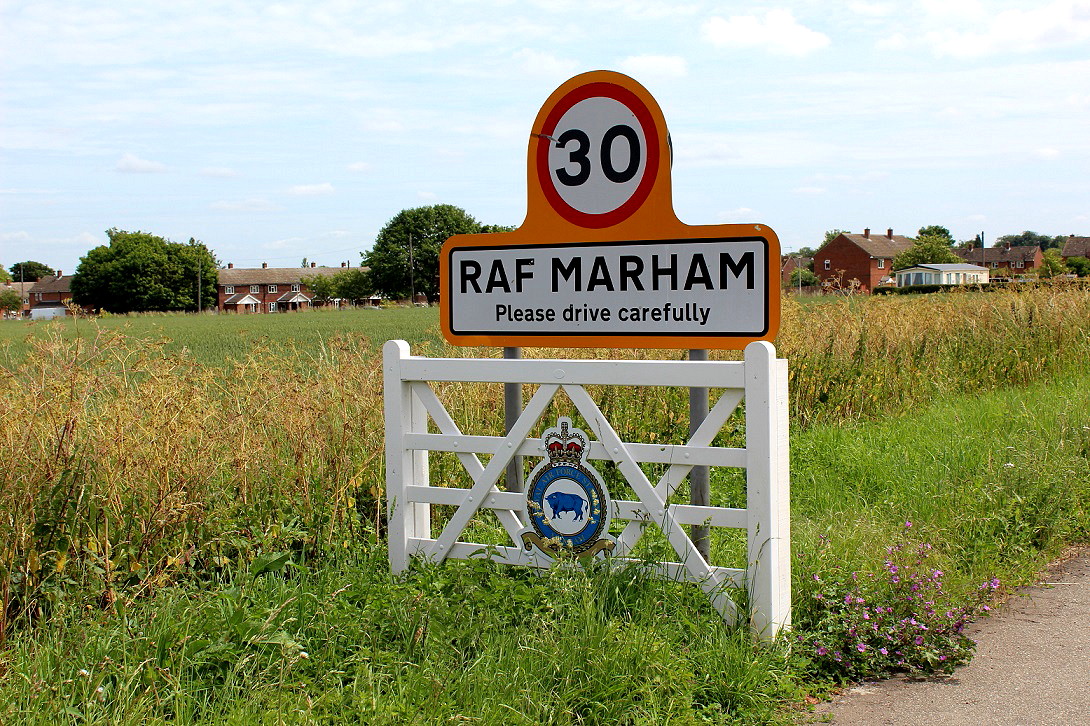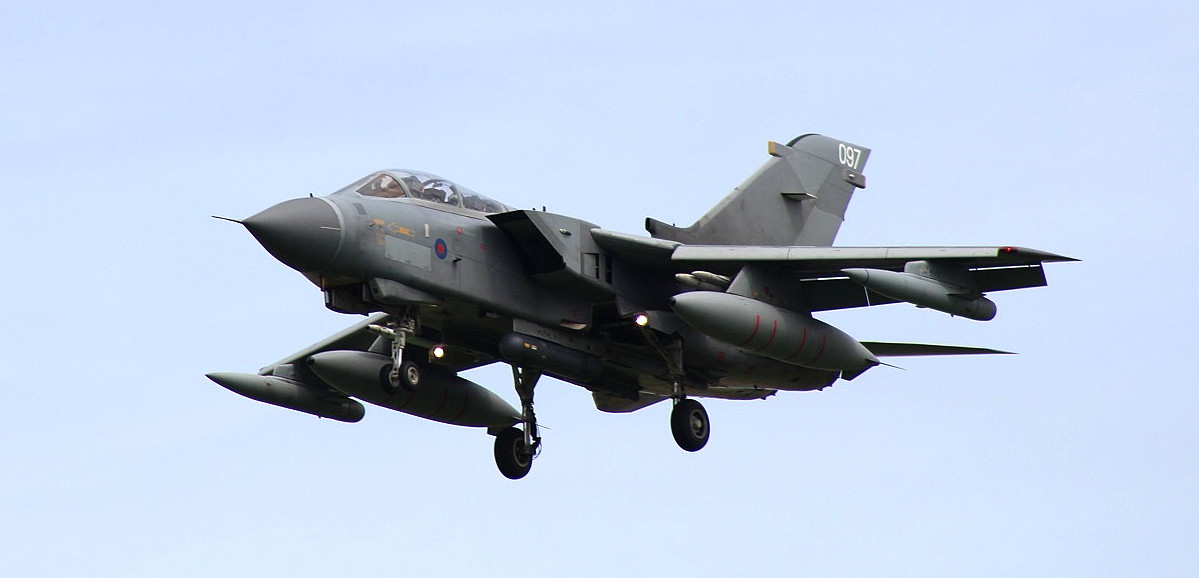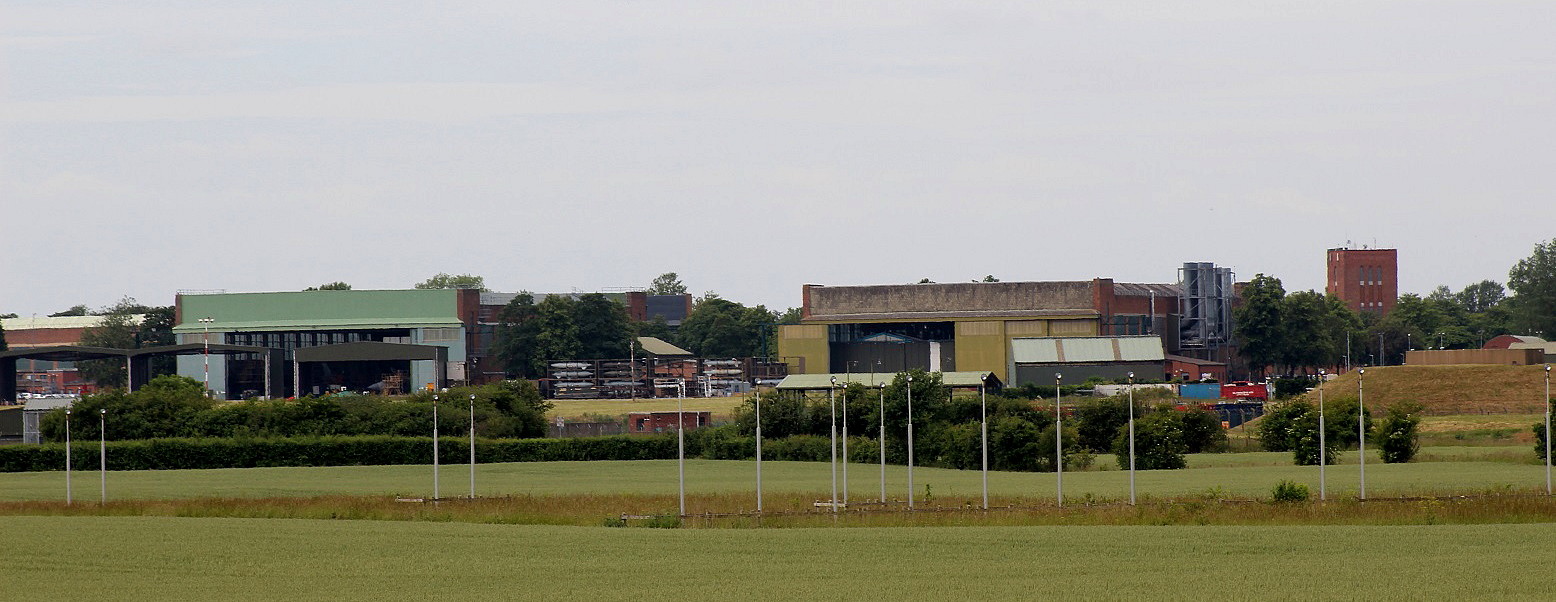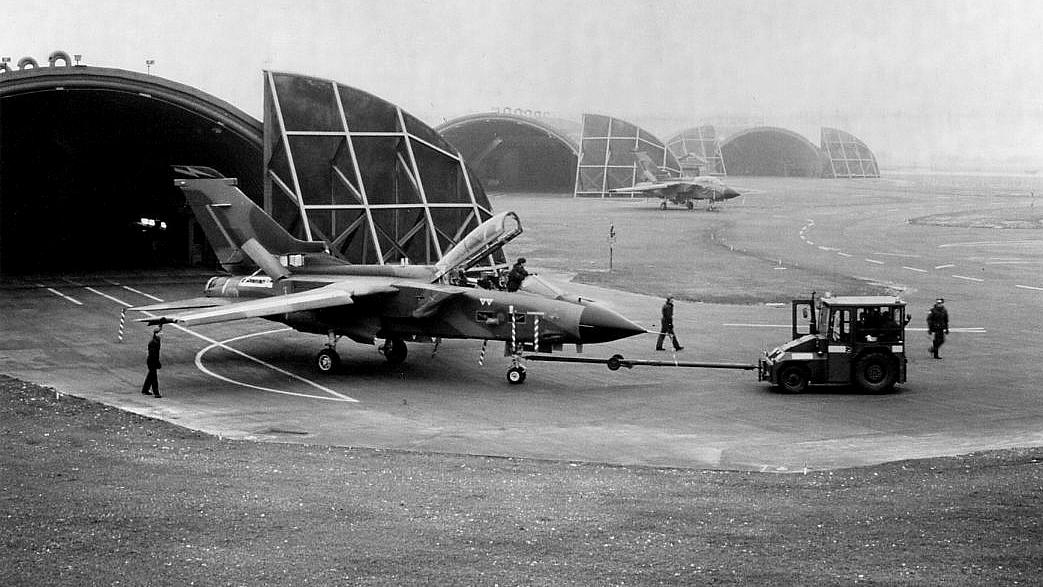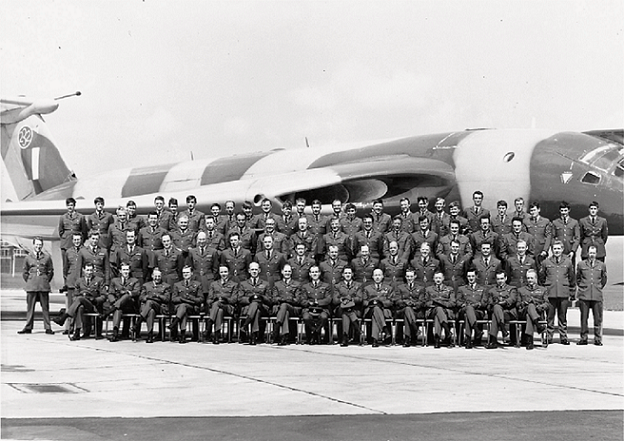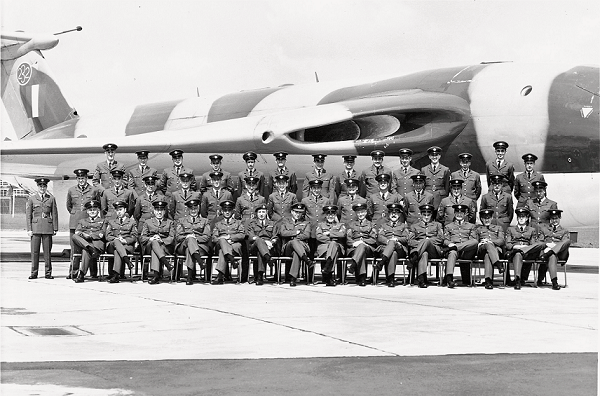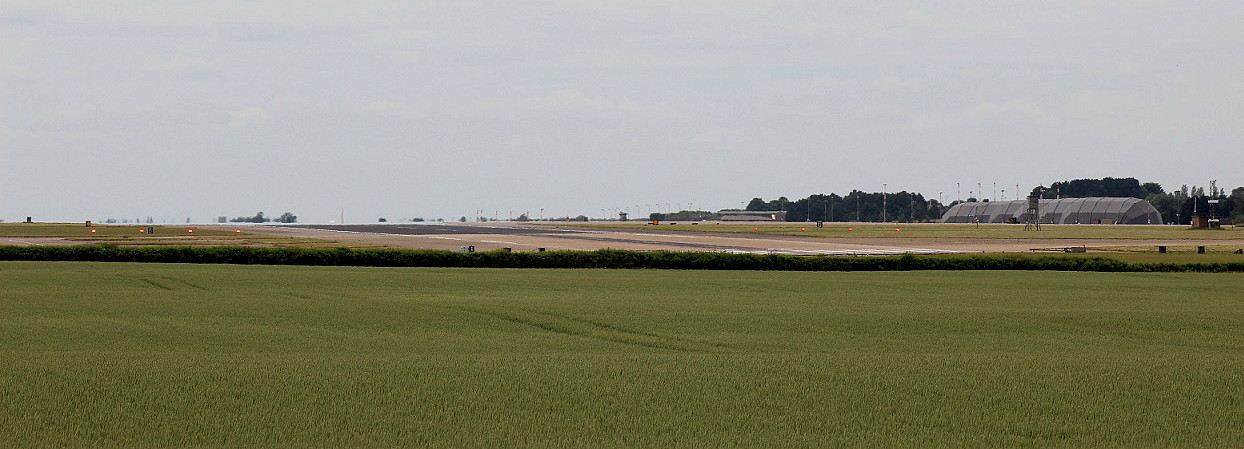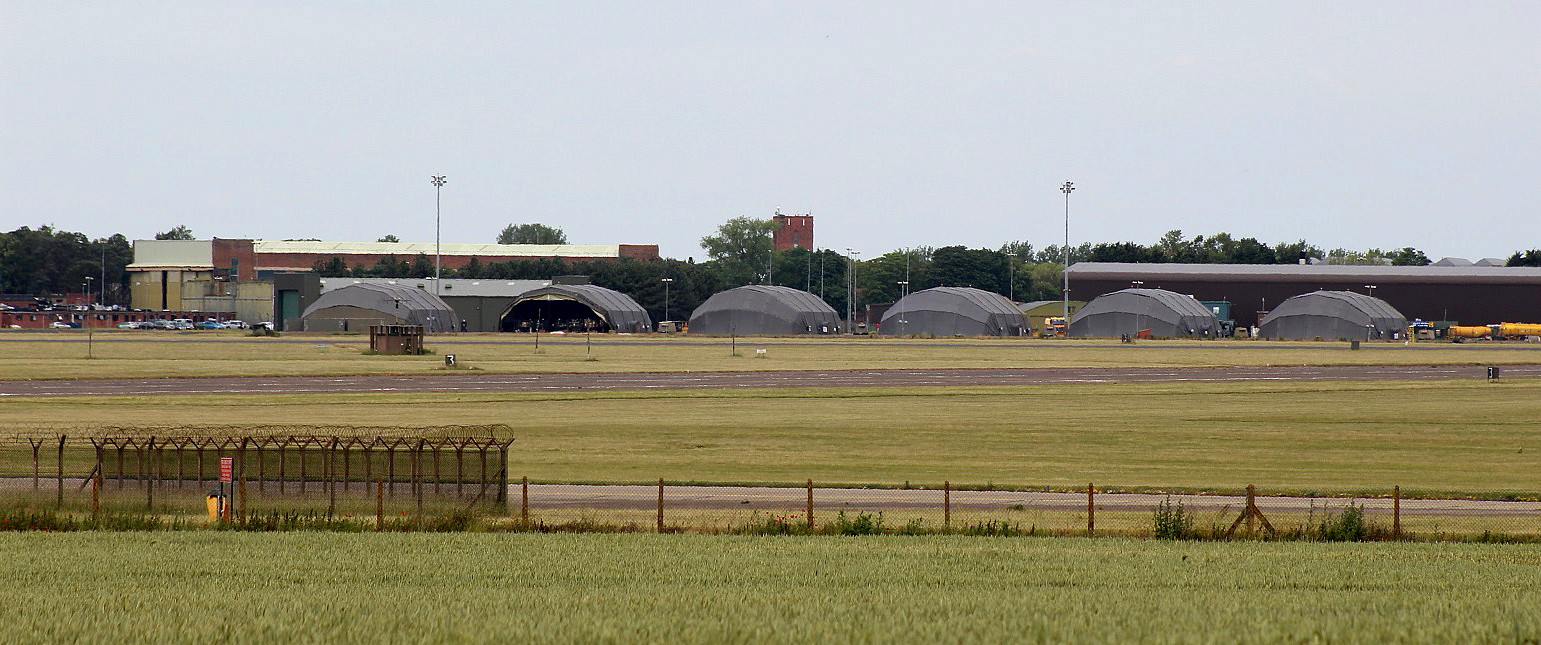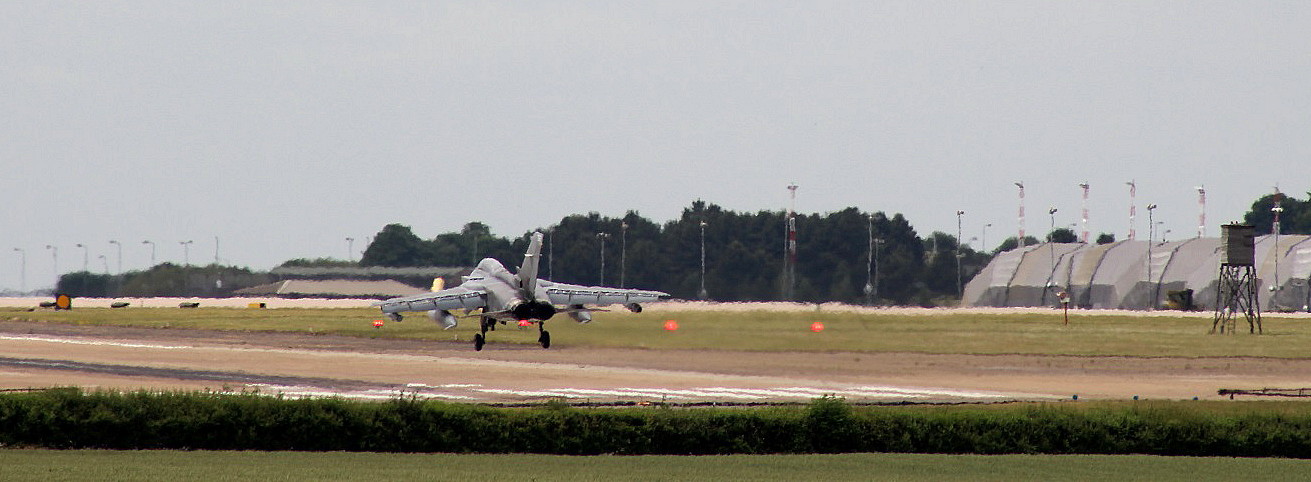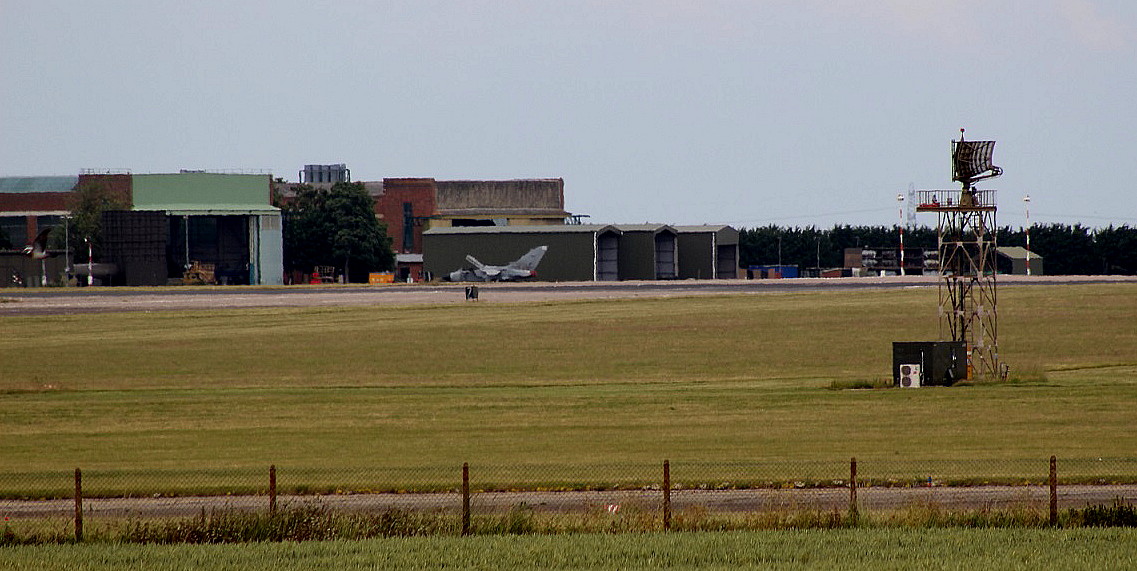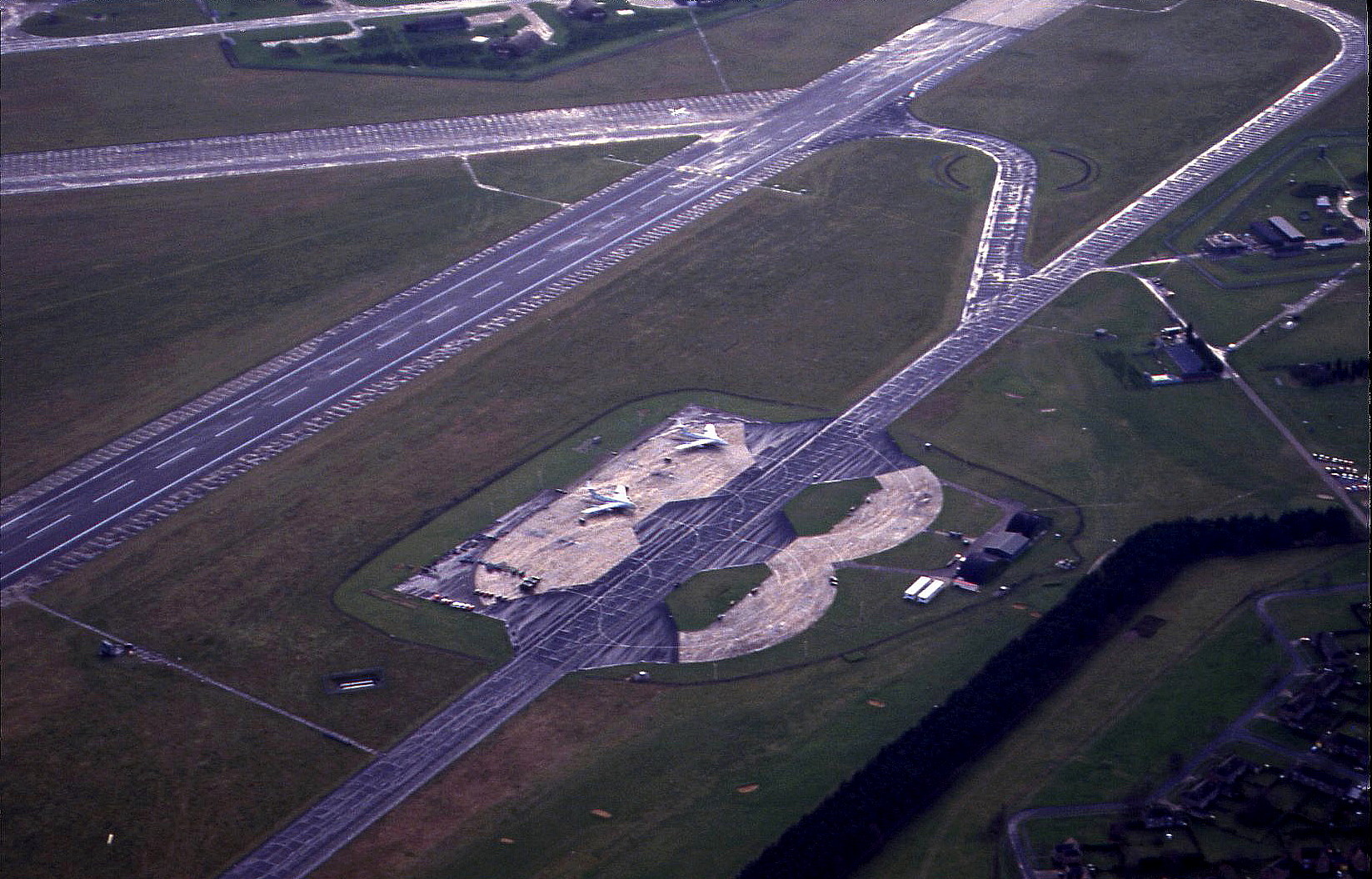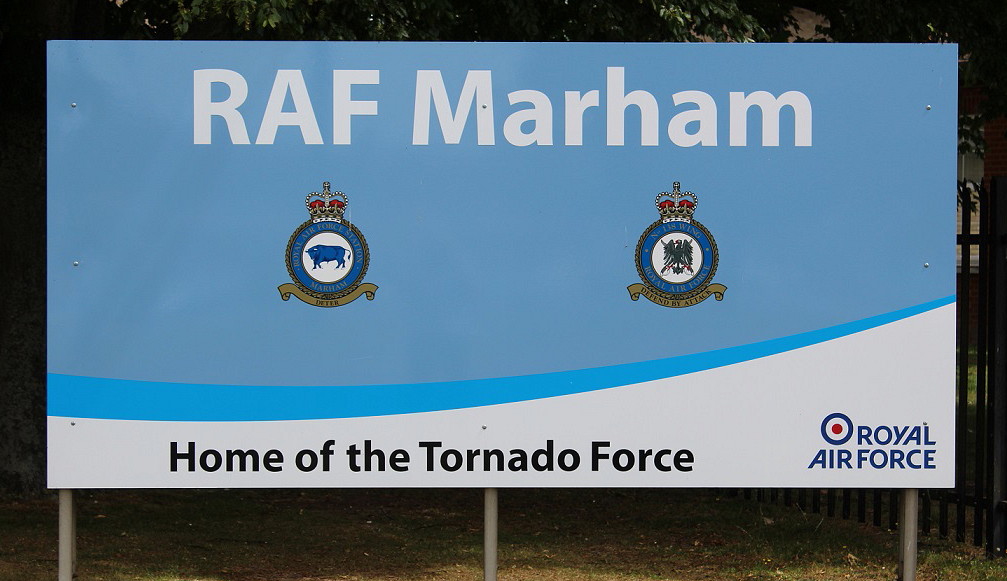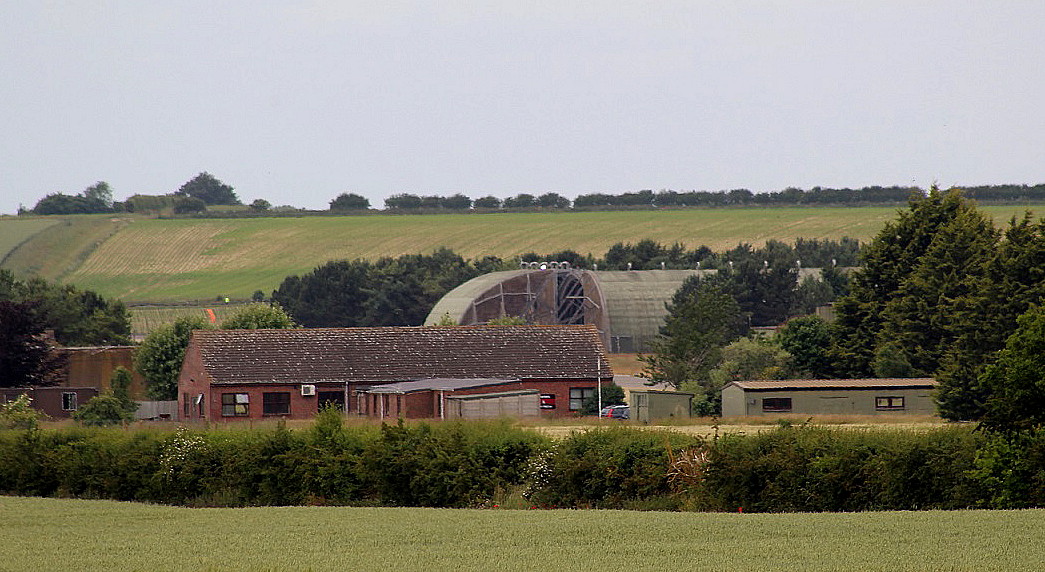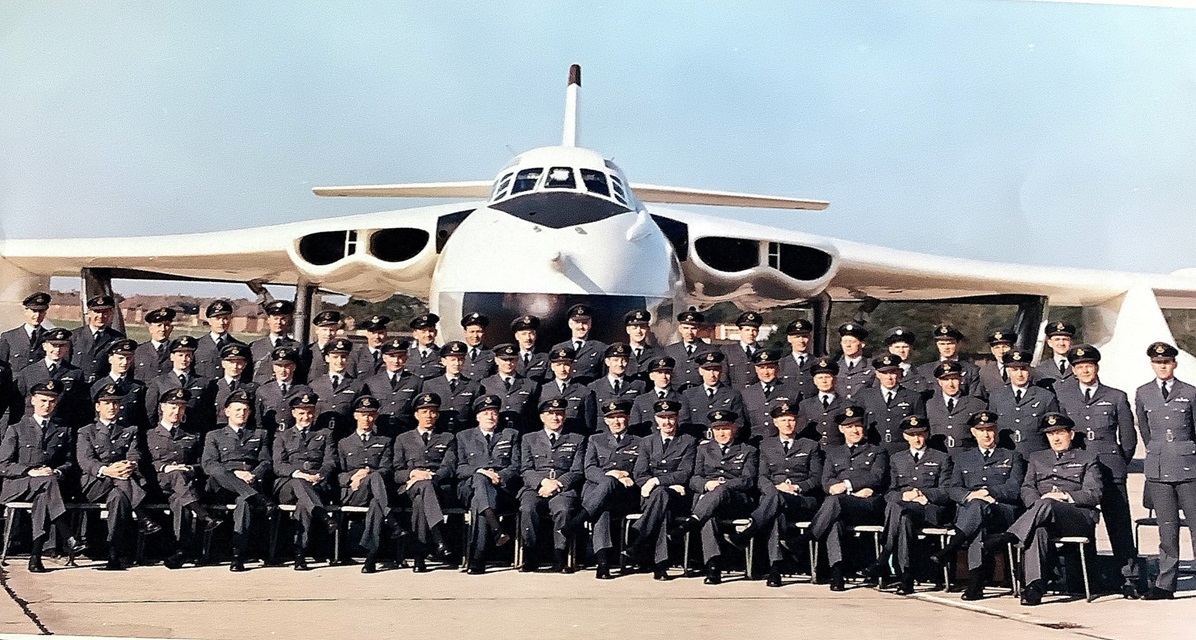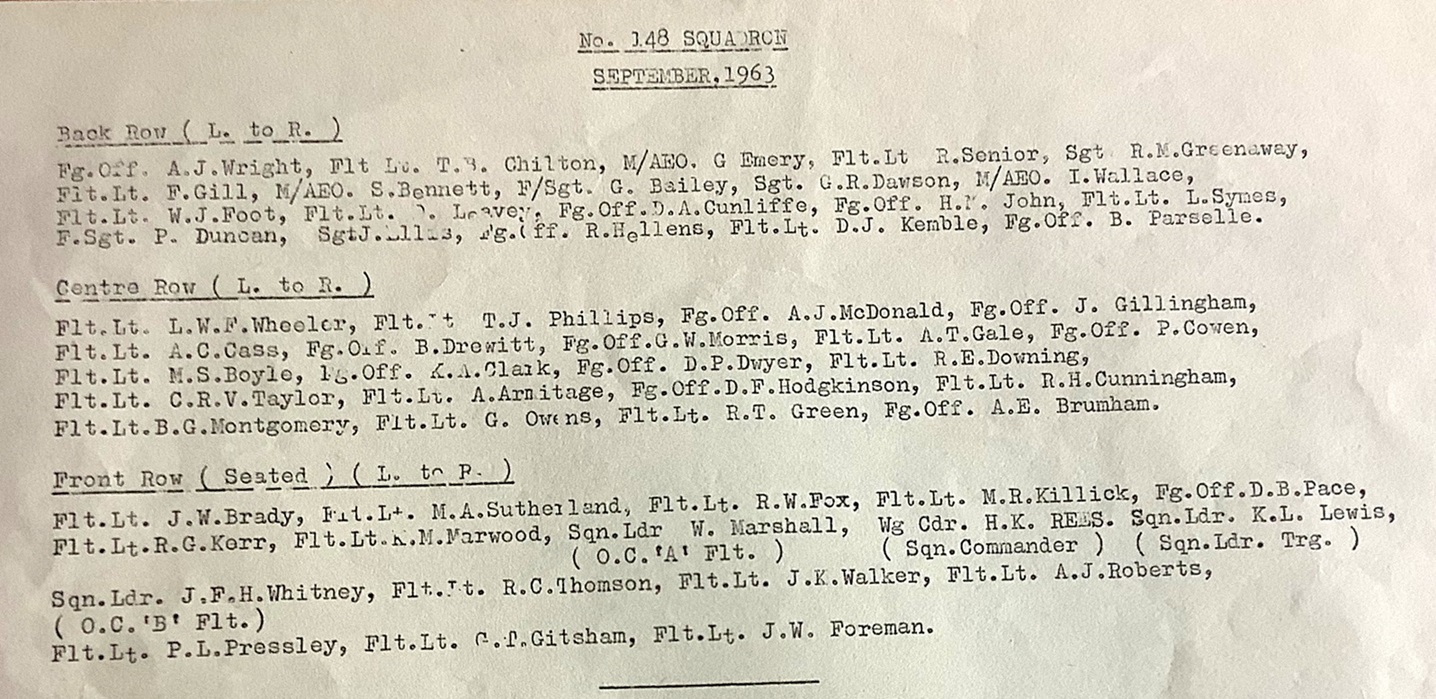Marham
MARHAM: Military aerodrome later large air base
Note: All these pictures were obtained from Google Earth ©
Second picture: Two Panavia Tornado's at the west dispersal point.
Fourth picture: Can anybody identify these two aircraft?
Fifth picture: 'Quick dispersal' hangars for the Tornado contingent.
Sixth picture: MARHAM under reconstruction in 2018.
Eighth picture: If these aren't helipads - what are they? And, if they are - why? The one lesson I have learnt during over twenty years of research for this 'Guide' is that it is very unwise to try and understand the military mindset.
Just look at the expanse of this base - to service a couple of dozen 'front-line' aircraft.
Note: All pictures by the author unless specified. First picture, an aerial detail of Marham by Austin J Brown as we overflew in the Cessna 172 G-WACL in November 1992. The third picture is of the Tornado GR4, ZD749, on short finals to land in June 2015. This fourth picture is of the control tower in June 2015.
Military users: WW1: RFC/RAF Home Defence Flight Station & Night Training Squadron Station
Between wars: RAF Bomber Command 3 Group
38 Sqdn (Fairey Hendons, later Vickers Wellingtons)
115 Sqdn (Fairey Hendons then Handley Page Harrows, later Vickers Wellingtons)
WW2: RAF Bomber Command (Under re-construction initially)
105*, 109 & 139 Sqdns (De Havilland Mosquitos)
218 Sqdn (Vickers Wellingtons then Short Stirlings)
487 Sqdn (Lockheed Ventura)
1655 MTU (Mosquito Training Unit)
Note: These two pictures from postcards were very kindly sent by Mike Charlton who has an amazing collection. See, www.aviationpostcard.co.uk
I suspect the Valiant in the second picture is probably a tanker version flown here by 214 Squadron from 1958?
Because the Vickers Valiant features in these pictures, it gives me another opportunity to bang on about what a fantastic aircraft the Valiant really was in its heyday. Its latter reputation was utterly undeserved and the result of complete incompetence by the most senior buffoons in the RAF and the Ministry of Defence. A familiar story?
Probably few people today (?) appreciate that the Vickers Valiant had such phenomenal performance that it could easily run rings around the then front-line RAF fighter, the Hawker Hunter. But, it was not designed for low-level operations, which it was later consigned to. In fact Vickers designed and flew a low-level version - but the ignorant idiots in charge declined to order it.
And, perhaps even more surprising, the Valiant was ordered basically as a 'fill-in' before the Avro Vulcan and Handley Page Victor became available.
Post 1945: RAF Bomber, Strike and Training Commands
231 OCU (Operational Conversion Unit)
61 Sqdn (Avro Lincolns)
In early 1946 the Bomber Development Unit and the Central Bomber Establishment were ‘integrated’ here.
A JIM ELEY GALLERY
After flying Lancasters with 514 Squadron at WATERBEACH, and a short term at METHWOLD, Jim was sent to serve at Central Bomber Establishment at MARHAM - the airfield also being occupied by the USAF.
44, 115, 194 & 207 Sqdns operated the Boeing B.29 Superfortress, (called the ‘Washington’ by the RAF), from MARHAM. Apparently 87 of the type were based here.
(It seems 115 & 207 Squadrons later converted to Canberras here)
2 & 39 Sqdns No.1 PRU (English Electric Canberras)
49, 90, 148, 207 & 214 Sqdns (Vickers Valiants)**
Note: 49, 90 & 214 Squadrons, at least, were equipped with Valiant tankers. Initially though, 49, 148 & 207 were bomber squadrons. 214 Squadron went on to flying the Handley Page Victor K1/K1A tankers)
55 & 57 Sqdns (Handley Page Victor tankers)
Note: Initially 55 & 57 Squadrons were flying the Victor B1/B1A bomber version.
TTF (Tanker Training Flight), later renamed 232 OCU (Operational Conversion Unit)
IX, 12, 27 & 617 Sqdns (Panavia Tornados)
Note: This first illustration is from a CAA chart in 2009 and also shows a number of other flying sites nearby. The second picture is of the first entrance sign seen when driving east on a minor road which leads to the northern side of the airfield. The third picture is of the Tornado GR4, ZD749, coming in to land in June 2015.
1998 snapshot: RAF Reconnaissance
2 Sqdn 13 x Panavia Tornado GR 1/1A
13 Sqdn 13 x Panavia Tornado GR 1/1A
39 Sqdn 5 x Canberra PR.9 2 x Canberra PR 7 2 x Canberra T 4 (No.1 PRU)
Note: For the first picture I have Ian Macfadyen to thank for identifying where this picture was taken.
The second picture was (and the third) kindly sent by David Vickery, (then 33 years old), and in the second row, second from left. In the third picture David is front row, third from left.
2012: 2, 9 & 31 Sqdns (Tornados)
Gliding: Listed as operating in 1975
Note: Fenland Gliding Club
Flying club: Marham Aero Club
Location: NW of A1122, 9nm SE of Kings Lynn
Period of operation: 1916 to 1919 then 1937 to -
Site area: WW1: 80 acres 677 x 503
Runways: WW2: 06/24 2743x91 hard 11/29 1829x91 hard
15/33 1829x91 hard
Note: These runways were extraordinarily wide in 1944 and the obvious question is -why?
2001: 06/24 2786x60 hard 01/19 1800x90 hard
NOTES: Was the WW1 aerodrome situated within the confines of present day MARHAM?
In his excellent book Avro 607 Rowland White tells this story: “On the 11 November 1918, aircraft took off from RAF Marham in Norfolk bound for the airfield at Narborough, just a mile and a half to the north-east. The most destructive war the world had ever seen was over and Marham’s airmen were going to celebrate Armistice Day by bombarding their colleagues with bags of flour. The unprovoked attack didn’t go unanswered for long. In retaliation, Marham was hit from the air with bags of soot. It was the last offensive action launched by either base before both were closed early in 1919.”
THE MOSQUITO ERA
*105 Squadron were the first to operate the bomber version of the Mosquito, the B.IV, and commenced operations in May 1942. They undertook the first raid against the Gestapo headquarters, in Oslo, Norway, on the 25th September 1942. As a low-level bomber especially the Mosquito was remarkably effective and many now famous raids were mounted, such as the plan to free French resistence fighters from Amiens prison (northern France) and the destruction of the Gestapo headquarters in the Hague, Holland (The Netherlands). Possibly the last major raid on Gestapo headquarters was Operation Carthage, to Copenhagen, Denmark on the 21st March 1945 by 21, 464 and 487 squadrons operating from RAF FERSFIELD. Other Mosquito bombing operations included a raid on Gestapo HQ in Amsterdam which appears to have escaped much attention.
One raid by Mosquitos was particularly effective and I will quote Robert Jackson in his book Britain’s Greatest Aircraft: “On 30 January 1943, the two original bomber squadrons, Nos 105 and 139, now at RAF Marham in Norfolk, combined to carry out an attack that had enormous propaganda value. The target was Berlin, the first time that the German capital had been visited by the RAF in daylight. On this day, a military parade was to be held to mark the tenth anniversary of Hitler’s Wehrmacht. In addition, a radio broadcast to the German people was to be made at 11.00 hours by Luftwaffe C-in-C Hermann Göring, followed by a second broadcast at 16.00 hours by Propaganda Minister Josef Goebbels.” Consider this, the straight line distance from Marham to Berlin is 540 miles, (and I assume they jinked a bit to throw the Germans off the scent?), and roughly two thirds of that was within fiercely defended enemy territory.
“The first attack was made by three Mosquitoes of No.105 Squadron, led by Squadron Leader R.W.Reynolds and Pilot Officer E.B.Sismore (navigator).They bombed at precisely 11.00 hours, interrupting Göring’s speech. In the afternoon, three aircraft of No.139 Squadron, led by Squadron Leader D.F.W.Darling, also headed for Berlin, but they were intercepted by enemy fighters and Darling was shot down. The other two made their attack on schedule about five minutes before Goebbels made his speech, and both returned safely to base.” I expect it is hard to imagine the consequent fury within the Nazi High Command that evening. It is also said that the propaganda value of this raid was so great that the existence of the Mosquito was then released to the British public.
THE PLANE THAT SAVED BRITAIN
In July 2013 a programme was broadcast on Channel 4, perhaps rather predictably given the sort of uneducated fools that largely run production in the media in recent years, with a ridiculous title – The Plane That Saved Britain. But, despite this, several good points were made in the programme; certainly the point that the extraordinary performance and capabilities of the Mosquito gave this country a pivotal advantage.
And – the type is perhaps now largely forgotten by the general public as a flying example does not exist in the UK. Which on the face of it is rather a disgrace. Without any doubt the Battle of Britain Memorial Flight should certainly have one to display. Another point made was that in each role assigned to the type, it excelled – be it, for example, precision bomber and pathfinder, night fighter, photo-reconnaissance, ground attack fighter/bomber and the U-boat hunter with a devastating ‘tank-buster’ cannon, etc.
A LITTLE KNOWN ASPECT
When the UK declared war on Germany in 1939, eight weeks later the British government decreed that the colour bar would be lifted for those in the Empire wishing to serve in the miltary. Some 6000 men from the Caribbean and West Africa volunteered to serve in the RAF who, alone amongst the three services, decided to accept this ruling - at least initially. Of these some four hundred were selected for aircrew duties.
One of these was Ulric Cross from Trinidad, who after training as a navigator went on to fly with 139 Squadron on Pathfinder operations, who of course only selected the elite of airmen in the RAF. He was the only West Indian in this squadron, who were also based at WYTON and UPWOOD.
If you are interested in this little known aspect of RAF operations in WW2, please visit my listing for ELSHAM WOLDS for more information.
THE START OF THE COLD WAR ERA
The above runway dimensions planned at the end of WW2, (the upgrade work was given as ending in August 1945), clearly shows that planning was afoot for much bigger and possibly ‘better’ things in the future. Can anybody now say what use these extra width runways were intended for? It certainly seems true that longer and strengthened runways were built at MARHAM, LAKENHEATH and SCULTHORPE for use by Convair B.36s in the early 1950s but had the forward planning at MARHAM gone this far back? It is said that in the event these three airfields were regarded by the Americans as being to prone to sneak enemy attacks, so BRIZE NORTON, FAIRFORD and UPPER HEYFORD had extra big and strengthened runways built to accommodate the B.36s.
Also in this vein it is sometimes stated that the Americans considered that in a nuclear war, the British bomber bases should be sacrificed first and, obviously, the British government and military agreed to this. I don’t understand this reasoning simply because, given such a small island, the distances involved would give virtually no advantage in practical terms. But of course, in those days to the military mind, even a few minutes advantage was considered a huge prize when it came to exterminating all human life within minutes over quite a large proportion of the world. The rest could die later, at their leisure, from the fall-out!
Looking back one does have to wonder at the mindset of all those involved in this essentially military nonsense, and just how they, (those in charge that is, including our government), all appear to have been sucked in. It does seem quite extraordinary, almost from the start, that some people on both sides weren’t saying, “Excuse me chaps – this prospect of nuclear war doesn’t have a future, so why don’t we all agree to pack it in, before it becomes really dangerous.”
ALMOST LAUGHABLE?
So much of what went on during the “Cold War” has now been exposed as being almost laughable if it wasn’t so damned serious at the time. Millions and millions of pounds spent in the most wasteful manner just to serve paranoid military top brass on both sides of the “divide”. As pointed out elsewhere in this Guide, all-out nuclear war was never an option – simply because there are no winners. Both sides knew this of course but the fiasco continued for decades until the Soviets under Mikhail Gorbachev, (arguably the greatest hero of the 20th century?), and undoubtably more pragmatic and intelligent in this sphere, suggested a halt to the proceedings with the Perestroika initiative.
As said elsewhere the brilliant boffins of the time were more than happy to help produce enough nuclear bombs to destroy the entire world several times over. Being a simple sort of bloke, I'd ask - isn't once enough?
On the other hand considering that this was supposed to be the height of 'The Cold War' a visit was arranged for Nicolai Bulganin and Nikita Khruschev to inspect the Valiants on the ground. Although not visible it the picture I have seen I expect there was a formidable line-up of Canberras too. A fly-past of sixteen English Electric Canberra B6s, twenty-eight Hawker Hunters and twelve Valiants was arranged. Some of the Hunters then put on an aerobatic display. This took place in April 1956.
THE QUEEN'S REVIEW
The Queen and Duke of Edinburgh attended MARHAM on the 23rd July 1956 for the Queen's Review. It is, I think, worthwhile to delve into the inter-web to see the Pathe News film - if only to clock the Royal couple's mode of transport along the flight line - it makes you proud to be British. On this occassion a fly-past of seventy-two Canberras and twenty Valiants took part. And yes, this is not a typo, I have double checked and the Pathe News commentator confirms it is correct. Can you imagine getting seventy-two Canberras into formation? The line must have stretched halfway across England, and/or the North Sea.
SOMETHING NOT GENERALLY KNOWN?
It appears that during WW2, in the European theatre alone, the RAF lost roughly 22,000 aircraft - and obviously a far greater number of aircrew. So, you might think that after WW2 these numbers of aircraft lost would have dwindled to next to nothing - a few hundred at most?
In fact it appears that between the end of WW2 and the end of the twentieth century, the RAF lost 7419 aircraft and 4850 crew! If this seems unbelievable to us today, and it certainly seems an astonish figure, it must be borne in mind that the majority if these losses occurred between 1945 and 1960, and by far the worst period was between 1945 and 1955. The ago of the first jets of course.
Many tend to become dewy-eyed with nostalgia upon seeing a Vampire or Meteor flying today, but in fact the single-seat versions especially - were killers. The cockpit designs were abysmal, the engines unreliable, and of course they were not fitted with ejector seats. I remember being told by one veteran who flew Vampires from COLTISHALL, that when his tour ended, only three of the original twenty-two, (or was it twenty-four?), had survived. And, the majority hadn't got more than two miles from the airfield.
I cannot see any reason why he should make this up, and indeed the figures seem to bear this apalling rate of attrition out. Regarding the cockpit design of the Meteor for example, the renowned Canadian test pilot Bill Waterton had a major run-in with Gloster management. And, the Javelin also for that matter, about which he issued an ultimatum for the company to address the numerous serious deficiencies. In the end this resulted in him being dismissed - which clearly says a lot about the companies lack of care and compassion for those tasked with flying their products.
MORE IMAGES OF MARHAM IN 2015
Notes: All these pictures were taken in June 2015.The third picture is of the Tornado GR4 ZD749 in the flare prior to landing.
A POTTED HISTORY OF LATER IN-FLIGHT REFUELLING AT MARHAM
As Rowland White mentions in Avro 607; by an amazingly coincidence Alan Cobham was, in World War One, a Second Lieutenant flying instructor at MARHAM and both were destined for greater things. “In 1982….over sixty years since the end of the Great War, the Norfolk airbase had become one of the largest and most important stations in the Air Force, and its main role was as home to the RAF’s entire fleet of Victor K2 aerial tankers. Without Cobham, the RAF might never even have had an air-to-air refuelling capability. After being demobbed, the young Second Lieutenant went on to become one of Britain’s legendary aviators and the world’s most passionate advocate of the potential of air-to-air refuelling. It was his persistence that culminated in Michael Beetham’s record-breaking long-range Valiant flights in the late 1950s.” By 1982, when the Falklands Conflict kicked-off, Michael Beetham had been knighted and become Air Chief Marshall of the RAF.
If he hadn’t acquired that status it can well be argued that the BLACK BUCK Vulcan Raid, (with just one Vulcan used eventually), would never have been attempted. As it turned out the first raid, only made possible with a complex aerial refuelling plan using eleven Victor tankers to get one Vulcan to the target, was a very chancy affair and only closely avoided an unmitigated disaster for the RAF. And, as Rowland White quite correctly points out, (contrary to popular opinion), those four raids had a very considerable effect on the Argentinians strategy – which, made the eventual victory far easier. For example the Argentinians realised, after the first raid on Port Stanley, that the RAF now had the capability to attack targets anywhere on their mainland, including Beunos Aires, their capital city. So, they deployed their Mirage fighters out of range of the Falklands to defend these potential targets – a grave mistake as it now turns out – because they were never considered. Bluff and counter-bluff techniques being a crucially important weapon in modern military strategy.
“In contrast to its American counterparts, the RAF was slow to embrace the possibilities the new air-refuelling technology offered, dismissing it, in 1947, as an exercise that was ‘not a paying proposition’. Cobham thought they were fools. With a series of pioneering flights to India, South Africa and Australia in the 1920s he had become one of the most well-known and respected figures in British aviation. In 1934, driven by a belief that air-to-air refuelling would revolutionize commercial aviation, he registered the name of his new company: Flight Refuelling Ltd. Five years later he was proving the efficacy of his ideas with a transatlantic air-mail service that was refuelled in flight. The system it used was developed by his new company at their base near the picturesque village of Tarrant Rushton in Dorset.” It now appears Mr White is mistaken here – prior to WW2 Flight Refuelling was based at FORD aerodrome in SUSSEX. It appears Flight Refuelling arrived at TARRANT RUSHTON in 1948 and most certainly after WW2.
“While this nascent operation ended with the outbreak of war, trials continued and in 1944 the Air Ministry awarded him a contract to supply the in-flight refuelling equipment for the Lancasters of the RAF’s TIGER FORCE then preparing to deploy east for the expected brutal, bloody and drawn-out offensive against Japan.” That was of course thankfully cut short when the USA decided to drop two atomic bombs. One on Hiroshima initially and, when that didn’t convince the Japanese to surrender, another on Nagasaki. The RAF then lost interest in air-to-air refuelling but Cobham had gained the interest of the USAF who had planned a surprise: “Before dawn on 7 December 1948 – the seventh anniversary of Pearl Harbour’s Day of Infamy – a heavily laden Boeing B-50 bomber clawed its way into the air from Carswell Air Force Base, Fort Worth, Texas, and, using the refuelling equipment Codham had saved from the scrapyard, flew non-stop to Hawaii to carry out an undetected mock nuclear attack on that same US Navy Pacific base before returning to Texas.”
By coincidence the Vulcans used in BLACK BUCK on the Falklands in 1982 were also retrofitted with equipment to drop conventional bombs recovered from a scrapyard. Perhaps scrap dealers deserve a medal too! Be that as it may, the USAF really rubbed the RAF top brass noses into the smelly stuff when: “Two and a half months later, another B-50 – Lucky Lady II – flew non-stop around the world. She was airborne for nearly four days.” But, it appears, the RAF still couldn’t see any advantage to them until, again pioneered by Flight Refuelling for the USAF, a method was devised to refuel airborne jet fighters which were notoriously short of range.
Note: The first picture by Austin J Brown was taken in November 1992, and shows two Victor tankers. The second picture is of the sign posted at the main entrance to Marham, taken in June 2015. The third picture, also taken in June 2015, shows a corner of the south side of the airfield with a bomb-proof hangar capable of withstanding an atomic weapon attack.
A CHANGE OF PLAN FOR THE ‘V’ BOMBER FORCE
Initially the ‘V Bombers’ were designed for high altitude attacks but it was soon realised that this was not a good idea, and very low-level attacks were the only viable option. Flying at low level means flying through, at high speeds, invariably encountering very severe turbulence and the RAF Vickers Valiants were the first to display signs of being overstressed. Incidentally Vickers had forseen this and had developed a low-level version, which the RAF top brass in their wisdom, saw fit to ignore. None were ordered.
To cut a long story short, and with the viability of air-to-air refuelling having now been proven, the Valiant was the first ‘V Bomber’ to be converted to a tanker role. The Handley Page Victor followed later. Only the Avro Vulcan, having been built along ‘The Forth of Firth Bridge’ engineering principles, could survive the battering at very low level and, it gave the crews a very rough ride. The TSR-2 was much, much better – so, needless to say, that project was cancelled.
THE VALIANT PERIOD
**The second Valiant Wing was established here in or around 1956. Some experts claim 49 Squadron were based here but I now think this is probably incorrect, and reckon they were actually based at RAF WITTERING (NORTHAMPTONSHIRE). 214 Squadron deserves a special mention because from 1958 they had been pioneering in-flight refuelling with considerable success. In late 1961, 90 Squadron, now with Valiant tankers were now based here having been previously based at HONNINGTON.
This gave MARHAM the accolade of being the first dedicated AAR (Air-to-Air-Refuelling) air base.
Looking at the records it seems quite difficult to ascertain the exact details. For example it is well known that a Vickers Valiant broke the speed record from London to the Cape (South Africa) on the 9th July 1959. Presumably it took off from MARHAM? This flight looks like the one in which a Valiant took just 11 hours 28 minutes to fly the 6,060 miles to Johannesburg.
In fact, as it now appears in 2016 following more research, that this Valiant made the flight non-stop in both directions. The aircraft being refuelled by two Valiant tankers over Kano in Nigeria.
Once in-flight refuelling was mastered by Valiants of 214 Squadron,, and in 1958 they really got into their stride. For example setting a record from MARHAM to Aden in 7 hours 10 minutes. Then MARHAM to Nairobi in 7 hours 40 minutes, followed by MARHAM to Salisbury (then in Rhodesia) in 9 hours 42 minutes. In October 1959 a Valiant of 214 Squadron made the first air-to-air fuel transfer to an Avro Vulcan and two years later, in 1961, a Vulcan flew non-stop to Sydney, Australia, being refuelled all the way from Valiants of 214 Squadron. However, the Valiant itself still had one last major feat to notch up when in 1960 a Valiant from MARHAM flew non-stop to Singapore.
Incidentally, 214 Squadron was later reformed at MARHAM in 1966, this time with Handley Page Victor tankers.
GETTING DISPERSED
In the excellent book Valiant Boys by Tony Blackman and Anthony Wright, they include an account by Graeme Kerr which mentions an aspect of the Cold War that I had never heard of. This was during the time when Vickers Valiants were operation at least. "To maintain the fifteen-minute, droppong to five-minute readiness states, it was obviously not possible to meet this target with more than a handful of aircraft airborne in five minutes."
"As a result, each squadron had two dispersal fields to which they would deploy at times of heightening tension. In the case of 148 Squadron our disperal fields were Manston in Kent and Tarrant Rushton in Dorset." If anybody can kindly offer more information about 'V' Bomber Squadron dispersal sites, this will be much appreciated.
FATAL SOUP
Following from above Graeme Kerr tells of the tragic accident to a Valiant of 214 Squadron at MARHAM: "....it happened just after take-off and the crew, including the crew chief, from 214 Squadron, were instantly killed. The tailplane trim was subsequently found to be faulty in that it operated in the wrong sense and once selected, ran the trim to the full extent of its travel."
"Amongst the sustenance for long trips were tins of soup and heaters for these were installed in the aircraft. It was found that over time, soup had dropped on to the trim switches on the control column, and this had somehow reversed the polarity of the switches." Needless to say, seen from today, the wisdom of consuming hot soup in the confines of a Valiant flight-deck seems highly questionable. I suppose, looking back, that the business of flying at high altitudes, 40 to 45,000ft for example, was little understood and the possibility of suddenly encountering CAT (Clear Air Turbulence) was not being taken into account?
THE SHORTEST 'V' BOMBER FLIGHT EVER?
Also in the account by Graeme Kerr is this story, from which I'll quote just a small excerpt. Unfortunately he doesn't mention the Squadron involved, but that doesn't matter. It involves an airshow in which three Valiants performed at Takali airfield on Malta, although the Valiants were based, usually for fairly short periods, at nearby Luqa. The date was the 27th August 1960.
"We performed our normal Valiant scramble and on the day we had all three aircraft rolling at the same time. Each had a different role to play before the crowds. I can't recall what the other two did but mine was a very steep climb away at minumum speed, not much above stalling speed! The Valiant could match the climb-away attitude of the Vulcan, but with less power the rate of climb was not as good. On this occasion I climbed to 2,000ft plus, did a quick wingover and descended straight onto final approach at Luqa. My flight time was exactly two minutes and thirty-five seconds."
THE CANBERRA PRU PERIOD
39 (No.1 PRU) Squadron was still using the Canberra at MARHAM until July 2006. A ceremony was arranged to mark the end of the Canberra in RAF service on the 28th July 2006. It is reported that RAF Canberras made their final flights on the 31st July, three being delivered to Delta Jets at KEMBLE (GLOUCESTERSHIRE).
AND FINALLY BUT CERTAINLY NOT LEAST
In October 2024 I had an e-mail from Josephine Cunningham asking if this picture of 148 Squadron at MARHAM in 1963 would be of interest? I was tempted to reply: "Is the Pope a Catholic?" Someone had suggested sending it to me. She told me that her husband Ron is an active ninety-one year old, and would love to hear from anybody in the photo, or someone related to them.
Flt. Lt. Ronald H Cunningham is in the centre row, 5th from the right.
As a rule I do not reveal contact details. But, here I make the rules - and what are rules for? Well......to be broken of course, otherwise little purpose in having them. Ask anybody who served in the RAF years ago. So, if anybody can kindly respond, make contact at: ronjocunningham@yahoo.co.uk
Peter Cornelius
This comment was written on: 2020-08-28 08:05:47The Valiant Period- Yes, 49 Squadron were based at RAF Wittering. While still being formed the first Flight of two aircraft went in 1956 to RAAF Edinburgh Field in preparation for the dropping of the Atomic Bomb at Maralinga. I went as ground crew and set up the Green Satin navigation aid so that the bomb was dropped where intended. Marham - The Valiant Period - My Flying Log tells me that 148 Squadron diversion Exercise "Mayflight II" was November 19th to 23rd, 1959, to to Filton, Bristol. There was another "Mayflight II" dispersal July 11th to 13th, 1960, for Filton. (I only have those recorded on which the ground crews flew. There were other dispersal exercises where we were coached.) Exercise "Micky Fin" (I don't know the significance of the differences in the names) was November 13th to 15th, 1963, was to Manston in Kent. These were in the days before QRA, which made such expensive exercises unnecessary. (Incidently, we had to get four aircraft airborn in FOUR minutes, not five, as stated on this web page.) Also during my time at Marham we had month long Operations "Sunspot" or" Maltex" with the Valiants to Luqa, Malta, May 1959 and July/August 1961. 586929 Peter Cornelius, Sgt. Air Radio Fitter (included Radar). Marham 148 Squadron 19th February 1959 to 22nd August 1951, 148 and Line Squadron23rd August 1951 to 15th June 1964. 214 Squadron 15th June '64 to 25th March 1965. I saw the Valiants being cut up at the Marham Station Dump as I drove out as a civilian to join IBM.
We'd love to hear from you, so please scroll down to leave a comment!
Leave a comment ...
Copyright (c) UK Airfield Guide















